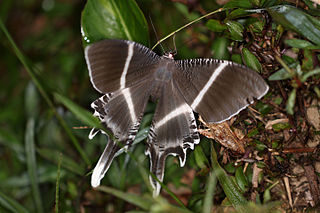
Castniidae, or castniid moths, is a small family of moths with fewer than 200 species: The majority are Neotropical with some in Australia and a few in south-east Asia. These are medium-sized to very large moths, usually with drab, cryptically marked forewings and brightly coloured hindwings. They have clubbed antennae and are day flying, and are often mistaken for butterflies. Indeed, some previous classification systems placed this family within the butterflies or skippers. The Neotropical species are commonly known as giant butterfly-moths, the Australian and Asian species as sun moths. The larvae are internal feeders, often on roots of epiphytes or on monocotyledons.

Paysandisia archon is a moth of the family Castniidae. It is native to Uruguay and central Argentina and has been accidentally introduced to Europe, where it is spreading rapidly. It is considered the only member of the genus Paysandisia.

Telchin licus, the banana stem borer, is a moth of the Castniidae family. It is native to South America, where it is found from Colombia, Venezuela and the Guianas, throughout the Amazon basin in Brazil and Peru. It has also been recorded as an introduced species in Hawaii.

Feschaeria is a genus of moths within the Castniidae family.

Feschaeria meditrina is a species of moth in the family Castniidae. It was described by Carl Heinrich Hopffer in 1856 as Castnia meditrina and can be found in Brazil.

Synpalamides is a genus of moths within the Castniidae family.

Synpalamides phalaris is a moth of the Castniidae family. It is commonly known from southern Brazil, Uruguay and Paraguay, but has also been recorded from northern Argentina and Trinidad.
Synpalamides escalantei is a moth of the family Castniidae. It was described by Jacqueline Y. Miller in 1976, and is known from Mexico.

Castnia is a genus of moths within the family Castniidae. It was described by Johan Christian Fabricius in 1807.
Castnius is a genus of moths within the family Castniidae. It was described by Jacob Hübner in 1819.
Riechia is a genus of moths within the family Castniidae containing only one species, Riechia acraeoides, which is found in Peru, Paraguay, Brazil and Argentina.
Castnia invaria is a moth in the family Castniidae. It is found in South America.
Dominickus is an extinct genus of moth in the butterfly-moth family Castniidae containing a single species Dominickus castnioides. The species is known from late Eocene, Priabonian stage, lake deposits near the small community of Guffey in Teller County, Colorado, United States.

Imara satrapes is a moth in the Castniidae family. It is found in Brazil, Paraguay and Uruguay.
Castnia estherae is a moth in the Castniidae family. It is found in Mexico.

Castnia eudesmia is a moth in the Castniidae family. It is found in Chile.
Castnia lecerfi is a moth in the Castniidae family. It is found in Argentina.

Tragocephala castnia is a species of beetle in the family Cerambycidae. It was described by James Thomson in 1857. It has a wide distribution in Africa. It feeds on Theobroma cacao.
Prometheus is a genus of moths within the family Castniidae. It was described by Jacob Hübner in 1824

Lyssa menoetius is a moth of the family Uraniidae. The species was first described by German entomologist Hopffer in 1856.











